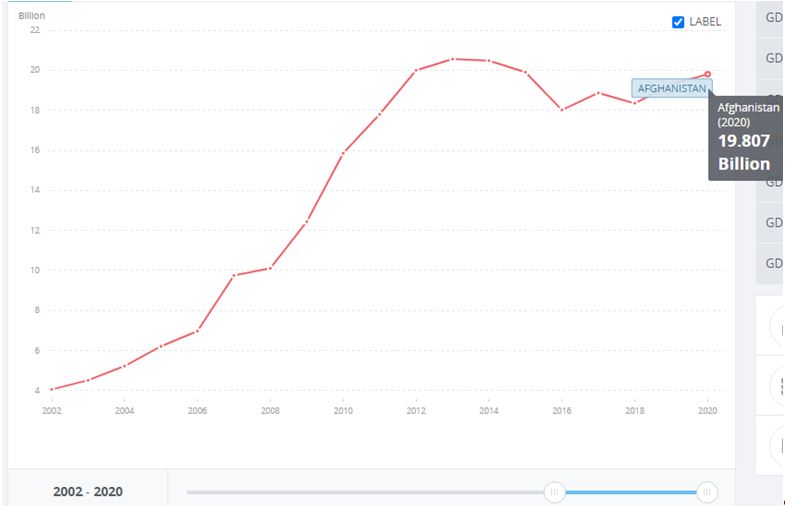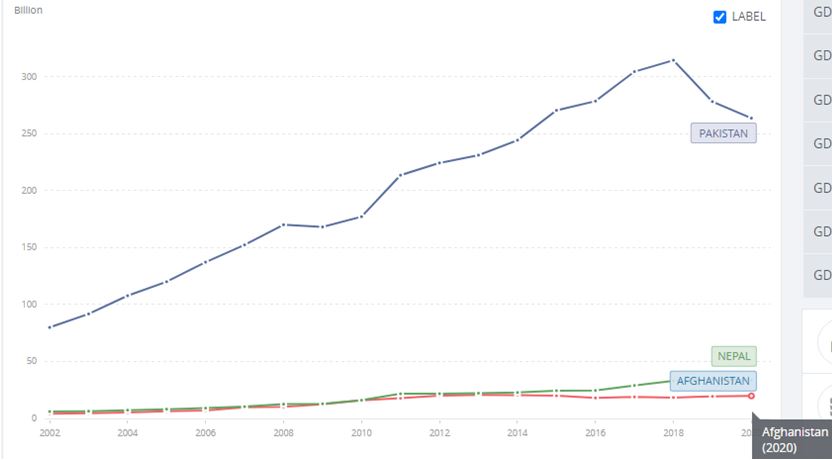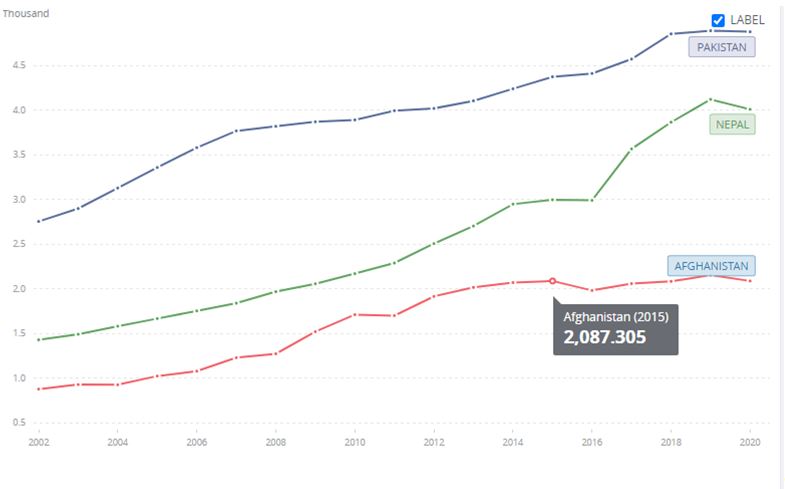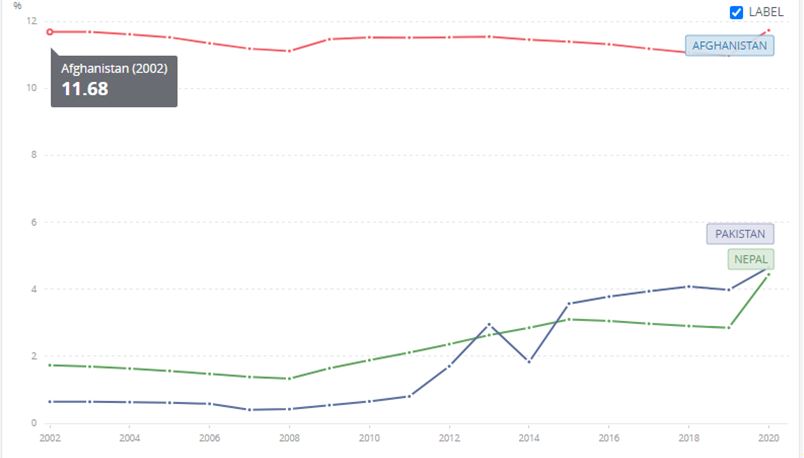By Tom O’Leary
The collapse of the US-led occupation in Afghanistan has rightly focused on the human cost of the 20-year war and the disastrous effects of Western interference in the country stretching back much further. But, despite what the US President now says, ‘nation-building’ became a central objective of the occupation and was used as a justification for other military adventures. All of that has been abandoned, as the US now has other, new Cold War priorities.
No prosperity
A striking feature of the economic impact of the US-led occupation was that there was no economic development. Various estimates, including by respected economists such as Stiglitz and Blimes, estimate the total cost of the war at trillions of dollars. If that is the case, almost nothing of it found its way into the Afghan economy.
According to World Bank data, the total output of the Afghan economy was equivalent to just $19.8 billion in 2019 in current US Dollar terms, a fraction of US total spending on the war. Worse, as Chart 1 below shows the Afghan economy has not been growing for years. Its peak level was in 2013 and has been sliding since.
Chart 1. Afghanistan GDP, 2002 to 2019, Current US Dollars

This is not a regional effect. It would be invidious to compare economic performance with oil-rich Tajikistan, Uzbekistan and Turkmenistan, or the Chinese powerhouse. But other countries have performed much more strongly, such as Nepal and neighbouring Pakistan.
Chart 2. Afghanistan, Nepal and Pakistan GDP, 2002 to 2019, Current US Dollars

As a result, average living standards in Afghanistan have failed to keep pace even with those in its poorest neighbours. Since the occupation, the gap with those countries has actually widened, and living standards are the same now as they were in 2015, as shown in Chart 3.
Chart 3. Afghanistan, Nepal and Pakistan Per Capita GDP, 2002 to 2019, Current International US Dollars

At the same time, the US/NATO forces occupation failed to provide any net new job creation at all. As Chart 4 below shows, while unemployment is a growing problem in Nepal and Pakistan, it is significantly outstripped by Afghan unemployment, which is no lower now than at the time of the invasion, as shown in Chart 4 below.
Chart 4. Afghanistan, Nepal and Pakistan Unemployment Total (% of workforce, using ILO modelled estimate), 2002 to 2019

Female unemployment is estimated to be 16.8% in Afghanistan, with no World Bank data available for prior years. This compares to 13.1% for Nepal and 6.1% for Pakistan.
In short, the occupation did not lead to any economic development. Instead, the economy and living standards have stagnated for years and even poor countries in the region fared much better economically than Afghanistan under the occupation.
Little social development
The repeated argument for bombing and invasion was that the invading forces would liberate the country, and especially women and girls from the vile and reactionary impositions of the Taliban. There can be no doubt about the profoundly misogynistic Taliban rule. But the claims for liberation, especially for women and girls, are not accurate.
The United Nations Human Development Indices have been developed by the UN Development Programme (UNDP). It is most comprehensive set of data available for many countries, including Afghanistan.
In the table below, taken from the most recent country report the UNDP shows the relative position of women and girls in Afghanistan and compares these with other (groups of) countries. In the first column the female/male relative position shows that the ratio of the development index of 0.659 is far lower for females than males in Afghanistan compared with other countries in the region, the region as a whole or comparably undeveloped countries. The overall level of development is also grotesquely low at 0.391 (column 2, HDI Values).
Perhaps the most startling evidence, given the widespread Western claims about the political purpose of the military campaign, is the reality of school life for Afghan girls compared to their neighbours and counterparts. While their expected years of schooling is 7.7 (and far below boys) the actual level of schooling on a mean average basis is just 1.9 years. This is less than half the level in Pakistan or the group of low development countries as a whole, and little more than a third of the school years for girls in the region.
Finally, not only is the per capita Gross National Income for Afghan women (last column) by far the lowest on all comparisons it is also more unequal than in the group of lowly developed countries. Only in Pakistan is the ratio of women’s incomes so atrociously low compared to men’s.

Not all of this can be ascribed solely to the legacy of the disastrous Taliban rule. The occupation has lasted 20 years and key indicators of both social deprivation and social inequality have not advanced even beyond the poorest and most unequal of neighbours. The Nepalese, the Pakistanis and others in the region and beyond are clearly better at manging their own affairs than the US and its allies have been at occupying and ruling Afghanistan.
Who benefits?
Sometimes, there is no grand plan behind even the most consequential of actions. Bombing and invading whole countries can be conducted without clear aims, a clear strategy or an exit, as recent history demonstrates.
However, it is impossible to conduct an adventure of such prolonged duration and so costly in terms of lives and funding, even if these are overwhelmingly accounted for solely in terms of US or Western lives and finances unless the adventure can be adjusted to align with the fundamental interests of an important constituency, lobby group or class.
It is not necessary to take the official statements of war aims at face value. It was said the war was necessary to remove bin Laden (who turned out to be hiding in a different country altogether) and then it was for ‘nation building’, which never happened.
Instead, it is necessary to ask, Cui bono? Who benefits? Who is doing so well out of the war that they can employ spokespersons, write op-ed pieces, establish think tanks, and fund Congressional leaders’ re-election campaigns? The completely corrupt Afghan leaderships installed by the US, especially Hamid Karzai and Hashmat Ghani, who initially fled Kabul with car loads full of cash, are the recipients of corruption, not the donors.
If highly regarded economists place the cost of the war in the trillions of US Dollars, and yet as noted the Afghan economy has been shrinking to a level below $20 billion annually, then funding must have left the country. In effect, the taxpayers of the US and elsewhere were not funding nation building in Afghanistan, they were funding US defence contractors, the Pentagon war machine, and a whole raft of ancillary suppliers, of everything from ‘security personnel’ to beer and burgers.
That is where the huge bonanza of public money went. Some have sought to account for the funds through the annual reports of US publicly traded companies and their stock price, which have both gained enormously. But the truth is that many of the contractors at the head of the trough are privately owned companies including the notorious Halliburton group or Blackwater company, which is in effect a US-aligned mercenary army. In turn, these firms developed deep links with both officials in government and Congressional leaders. Former US Vice President Dick Cheney later become CEO of Halliburton.
In the US currently, unlike Britain which faces a specific humiliation of its own, there is only limited criticism of the Afghan withdrawal. Once Obama signalled the end of the occupation and Trump struck a peace deal with the Taliban, it was clear that the bonanza from this war was over. Meanwhile Biden is sharply increasing the military budget, as part of the pivot to China and the new cold war. Shareholders and privateers will not lose out.
Why failure, why now?
The US is a vastly better equipped military machine than anything the Taliban can muster. In terms of conventional forces alone it has 2.1 million active or reserve personnel. The direct military budget is over $750 billion in the current year. Using US military intelligence sources, the New York Times estimates that the Taliban has no more than 2,000 to 3,000 full-time fighters, even if it can call on up to 10,000. Its budget can probably be counted in the millions, not the billions.
In such a mismatch, there must clearly be a problem with the greater force and its inability or unwillingness to use its weight. Of course, there is a world of a difference between being a local insurgency which can simply return home before returning to the fight once more, and an occupying force which must either spread itself all over the terrain, or hole up in a small number of larger centres.
But it was clear to Obama and successive Administrations that they would have to commit more, not fewer troops to defeat the Taliban and even that was not guaranteed to be an enduring victory. Meanwhile the US has identified other priorities.
When asked about the US support for the Mujaheddin against the Soviet-backed government of Afghanistan, US national security adviser Zbigniew Brzezinski argued that the Mujaheddin offered no fundamental or strategic threat to the interests of the United States. So it is with the Taliban. The US has allies who commit beheadings and deny women all rights. And itself and allies regularly carry out acts of terrorism.
But this only explains why the US is willing to accept a defeat, not why it decided to withdraw now. Biden explains this decision now in these terms, “Our true strategic competitors — China and Russia — would love nothing more than the United States to continue to funnel billions of dollars in resources and attention into stabilizing Afghanistan indefinitely.”
The echo of Brzezinski’s comment is audible. The real threat to US interests, according to Biden is China and Russia, not the Taliban. It is also clearly his judgement that operations in Afghanistan could be a never-ending drain on US resources. That must be prevented and instead they must be redirected towards the strategic competitors, or the main enemy in military/political terms.
Conclusion
The Afghan war was never going to end in the victory that its architects such as Bush and Blair claimed. It was a punitive war followed by occupation, which can only create resentment and hostility. The elimination of bin Laden was largely irrelevant to the conduct of the war and the claims made for nation building or for liberation of women and girls were overwhelmingly false.
Instead, there was a huge bonanza, for the US military establishment, for defence companies and private contractors, which amounted to a powerful lobby for never-ending wars.
But the political decision has been taken to end the war, not on grounds of morality or even cost. Instead, the US has identified a strategic enemy in China along with its Russian ally and the entire focus must be directed towards blocking its rise. This is the new number one aim and overwhelming priority of the US.

Recent Comments